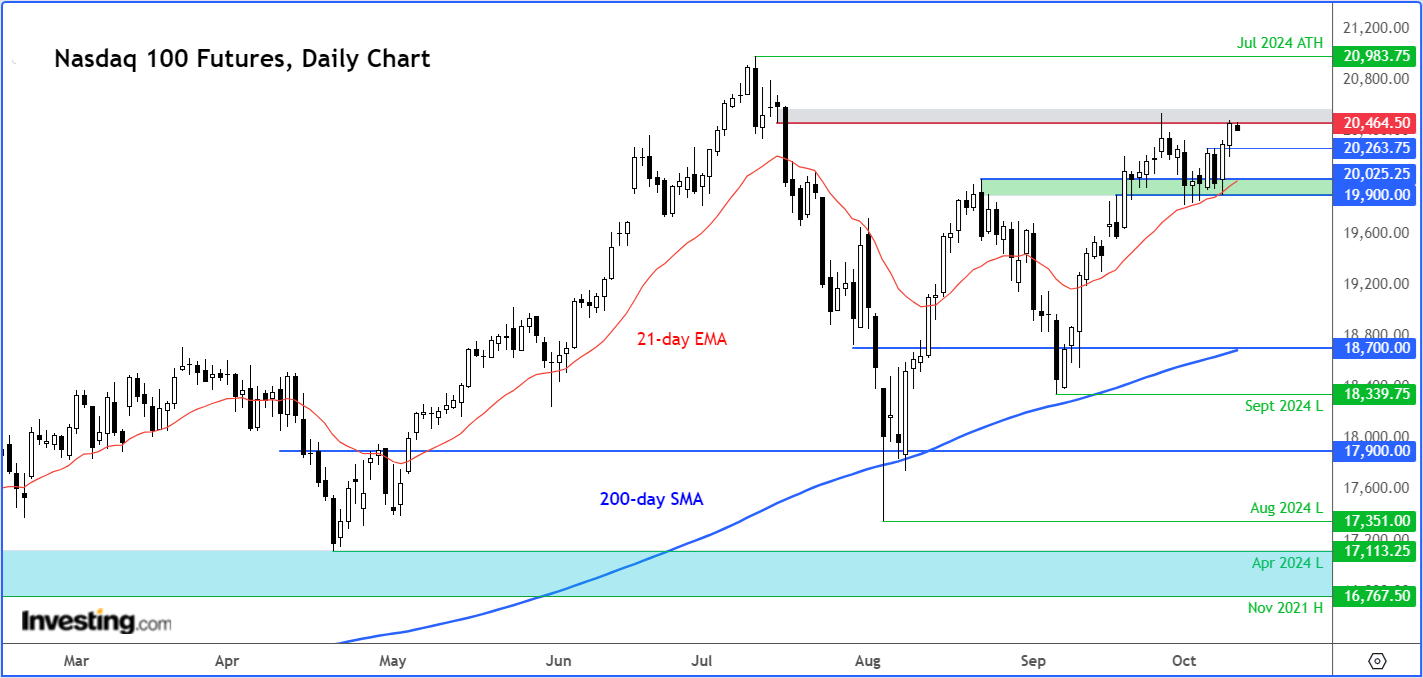- Traders need to monitor key support levels in the Nasdaq 100 amid market uncertainties.
- Today's inflation data could shift the momentum for the tech index.
- Caution is crucial as the index has surged from recent lows, necessitating disciplined strategies.
- Looking for actionable trade ideas to navigate the current market volatility? Unlock access to InvestingPro’s AI-selected stock winners for under $9 a month!
The market seems to have had every reason to fall, yet here we are with the S&P 500 hitting new record highs yesterday ahead of today’s inflation report, who is to say that the Nasdaq 100 can’t follow suit?
If today’s CPI comes in hotter than expected, it’ll be interesting to see how markets will react. Already, we have seen the 10-year bond yields surge back through the 4.0% level, rising about 50 basis points since the Fed's rate cut in September.
So, is this really a "Fed pivot?" Or are Treasury yields just responding to inflation concerns while the Fed continues to lower rates? Whatever the case, something does not look right about this rally.
This doesn’t mean people should necessarily start shorting the market, given that we don’t have a bearish signal to work with just yet.
More to the point, bullish traders should as always exercise caution, but now even more so, with any new trades from here on, taking it from one level to the next and tightening stops.
This is especially the case since we are already now a good 18% or so higher on the Nasdaq from the August low and around 11% from the September low.
Markets Defying Expectations
Despite everything—wars, recession fears, high interest rates, political and geopolitical tensions, and a weak Chinese economy—the US stock market keeps pushing higher.
The S&P is now nearing $50 trillion in market cap for the first time, up over 22% this year. Even when the yen carry trade unwound, causing a near 10% dip, it was quickly bought up in under a month.
And while we typically see a 25% rise in volatility during election years, the CBOE Volatility Index is sitting around 20, with the S&P 500 unfazed, which is remarkable, to say the least.
Meanwhile, China's economy is dealing with deflation and slowing growth, but even massive swings in Chinese equities haven’t rattled US markets.
It’s incredible that, amid all the uncertainty around inflation, the Fed's interest rate path, and the economy, not to mention the upcoming third-quarter company results, investors are continuing to buy stocks.
So why are markets still going up? Could it be that the strength of the US stock market is tied to the government’s record deficit spending? Whatever it is, this sort of run we have had this year is truly remarkable, one that may not last very long.
But until the charts haven’t created a bearish reversal pattern, try not to pre-empt a drop as that could be quite costly – as I am sure many people have found out.
Nasdaq 100 Technical Analysis and Trade Ideas
From a purely technical point of view, the trend is clearly bullish on the Nasdaq.
As you can see from this Nasdaq futures daily chart, the index has been making higher highs and higher lows ever since it bottomed out in early August following the yen-funded carry trade unwind.
Since then, it has reclaimed the 21-day exponential moving average and broken a few key resistance levels, which have since turned into support. So, the path of least resistance is to the upside until the charts tell us otherwise.

The first line of defense for the bulls comes in at around 20,260ish, which was resistance until we broke above it on Tuesday. This level is now the first line of defense for the bulls.
If they successfully defend it, then the next aim is to get through the next area of resistance starting at around 20,465 to 20595, an area which has now been tested twice in the last three weeks or so. The July high stands at 20983.
But as traders, we need to continually monitor the charts as anything can happen at any moment. With that in mind, and given the abovementioned fundamental considerations, always be on the lookout for a potential reversal to:
- (a) Get out of the way as quickly as possible
- (b) Take advantage of a potential drop by finding short trades.
So, should that 20260 support level give way decisively, then we could see the index drop to retest the 21-day exponential moving average and prior support and resistance range between 19,900 to 20,025.
This area is shaded in green on the chart and is basically the line in the sand for me.
I will get bearish on the Nasdaq should the abovementioned 19,900 to 20,025 range break down in the coming days. If that happens, then we could see the index stage a deep correction, and possibly head down to the 200-day moving average at around 18,700.
But we'll cross that bridge if and when we get there. For now, let's see if the above-mentioned support levels will hold.
***
Disclaimer: This article is written for informational purposes only; it does not constitute a solicitation, offer, advice, counsel or recommendation to invest as such it is not intended to incentivize the purchase of assets in any way. I would like to remind you that any type of asset, is evaluated from multiple perspectives and is highly risky and therefore, any investment decision and the associated risk remains with the investor.
